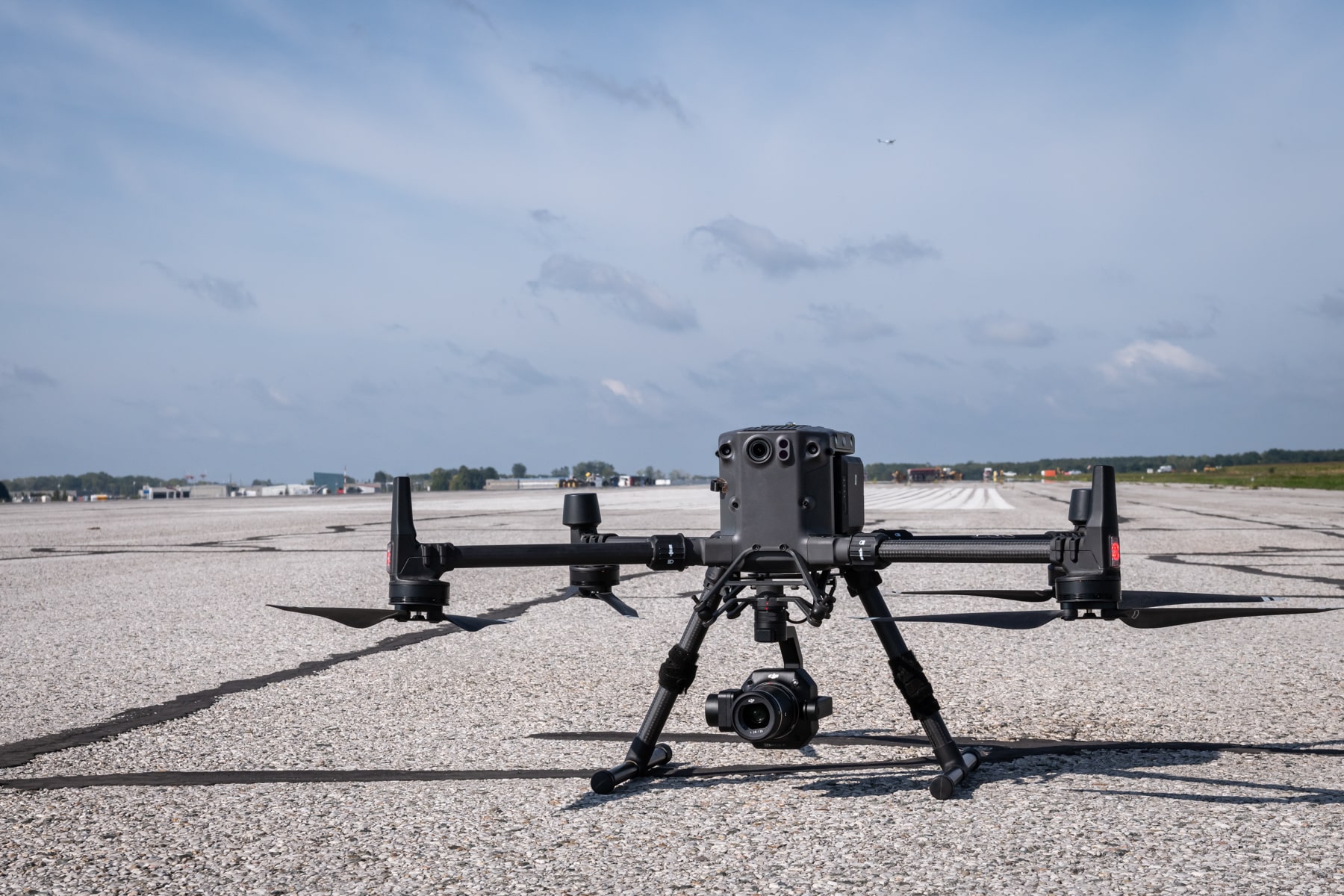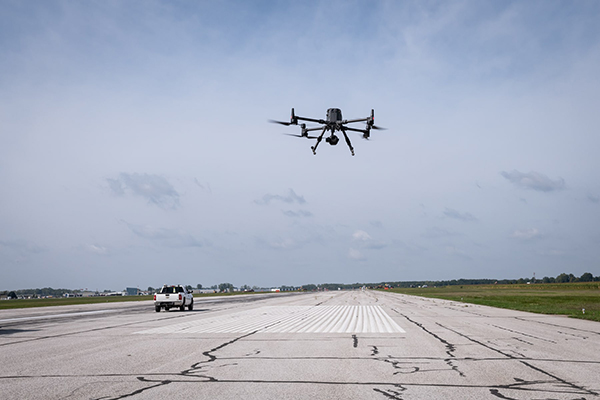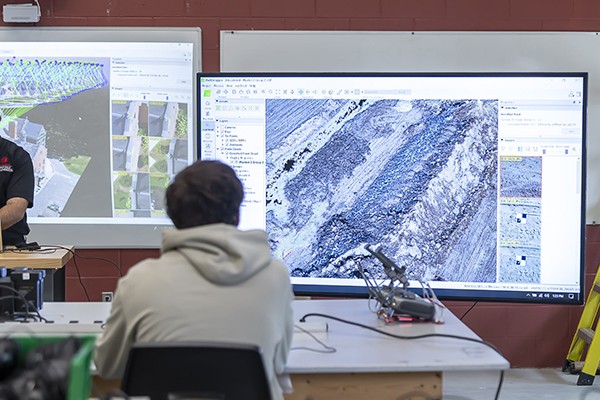Once dominated by the world of hobbyists and enthusiasts, drones are now transforming how companies operate across many industries! These high-tech flying machines, also known as Remotely Piloted Aerial Systems (RPAS), are not just cool gadgets – they're powerful tools companies can use to streamline operations, boost efficiency, and create new possibilities.
Interested in ways you could take advantage of this new tech? Check out our top 9 drone uses for businesses below.
Explore our graduate certificate in drone maintenance and operation
1. Drones For Emergency Response
First responders use drones for emergency response situations like wildfires, floods and search and rescue missions. Drones can navigate difficult terrain from above and enter dangerous situations without risking human life making them valuable tools. As technology advances, drones boast longer flight times while tools like thermal imaging allow them to spot missing people quickly in challenging topography, so rescue teams know their exact location. Drones collect data that can be used to assess situations quickly and make predictions about things like weather patterns or the spread of wildfires.
2. Drones in Agriculture and Farming
Drones have also found their place in the farming and agriculture industry. Their ability to fly over large areas efficiently makes them ideal for a variety of tasks, from spreading seeds and monitoring plant health to performing security patrols of crops and livestock. High-resolution cameras capture detailed images of potential issues, while high-payload spraying systems can distribute fertilizer, water or seeds precisely.
3. Drones for Healthcare
You may not think of drones as a healthcare tool, but they are already transforming healthcare behind the scenes. Drones can expedite critical deliveries requiring stable conditions, such as blood or organs, directly to patients in situations where traditional road transportation falls short. This technology bridges the gap in remote areas and ensures these delicate supplies reach patients quickly. The future holds even more promise as drone technology continues to evolve, with the potential to revolutionize not just remote healthcare, but also patient care within hospitals and even at home.
Rwanda & Drones in Healthcare
These rapid delivery capabilities are being put to the test in Rwanda with great success. As of September 2021, more than 75% of blood deliveries outside of Kigali, Rwanda’s capital, are made by Zipline drones. This is a game changer in a country where the majority of citizens live in remote areas, often facing a difficult journey to medical facilities. Previously, blood deliveries were challenging due to long distances and hot temperatures. Rural facilities often had to order excessive blood in advance, leading to a significant amount of wasted blood. When drone deliveries became available, facilities could receive blood quickly and on demand, eliminating the need for large, wasteful stockpiles.
4. Drones for Construction
Safety, efficiency, and cost savings – these are the promises drones bring to the often-challenging world of construction. Drones can survey entire sites in minutes with high-resolution cameras and mapping software. This data helps construction professionals identify potential safety risks or delays and track the progress of a project. By taking detailed images and videos of hard-to-reach areas, drones help identify potential safety risks for workers and prevent accidents. The vast amount of data drones collect empowers construction professionals to make informed decisions, understand project timelines, and ultimately, save money.
5. Drones for Surveying
Drones can do more than just surveying at construction sites. With drones, surveying difficult areas like dense neighbourhoods or undeveloped land becomes more efficient. Imagine surveying a steep cliff face - drones capture the entire area with high-resolution cameras, saving hours in comparison with a ground crew. This goes beyond tricky terrain. Drones are changing how we gather information, from inspecting airport runways to creating topographic maps.
6. Drones for Mining
The mining industry has also embraced drones. While future capabilities may include mineral extraction, they already play an important role in the mining industry. Beyond surveying, drones can inspect hard-to-reach or large areas for dangers like rock falls or gas leaks, keeping workers safe. Equipped with special sensors they explore new areas for potential mineral deposits and generate 3D models, helping to optimize future mining operations for better results.
7. Delivery Drones
The idea of delivery drones has created a buzz in recent years but implementing them safely will be challenging. In more populated locations or areas with more air traffic, safety risks like collisions and malfunctions leading to property damage or injury are major concerns. Logistical challenges include airspace regulations, battery life limitations for long-distance deliveries, and a lack of robust infrastructure for safe take-off, landing, and package delivery. Despite these obstacles, companies and regulators are actively exploring solutions. Widespread adoption of drone delivery in populated areas may still be some time off but the potential benefits continue to drive innovation and pave the way for a future where drone deliveries are commonplace.
8. Drones for Wildlife Monitoring and Conservation
The same features that make drones valuable for industrial and business uses, like taking detailed images and videos of the world below, are also great for wildlife conservation efforts. Unlike traditional methods, drones observe animals from above, causing minimal disruption. They cover large areas quickly, tracking animal movements, collecting data about things like population counts and habitat health and identifying threats like poachers. Real-world examples of drones in conservation include tagging whales with data-collecting sensors, poaching prevention through large-scale patrols and monitoring sea turtle nesting sites.
9. Space Exploration Drones
Beyond Earth’s atmosphere, drones offer a unique perspective for scientific discovery. Remotely piloted vehicles have been used for space exploration for decades, including several different iterations of Mars rovers. But in April 2021, the Ingenuity Mars Helicopter took the first powered, controlled flight on the Red Planet. Unlike rovers, this lightweight craft can soar above rugged terrain, capturing high-resolution images and vital data on the Martian atmosphere. This aerial viewpoint allows scientists to scout for future landing sites, map geological features in 3D, and analyze atmospheric composition. Ingenuity's success demonstrates the potential of drones in space exploration, beginning a new era of discovery on Mars and beyond.
Could your career benefit from drone expertise?
Learn more about our grad certificate on drone operation, maintenance and more







